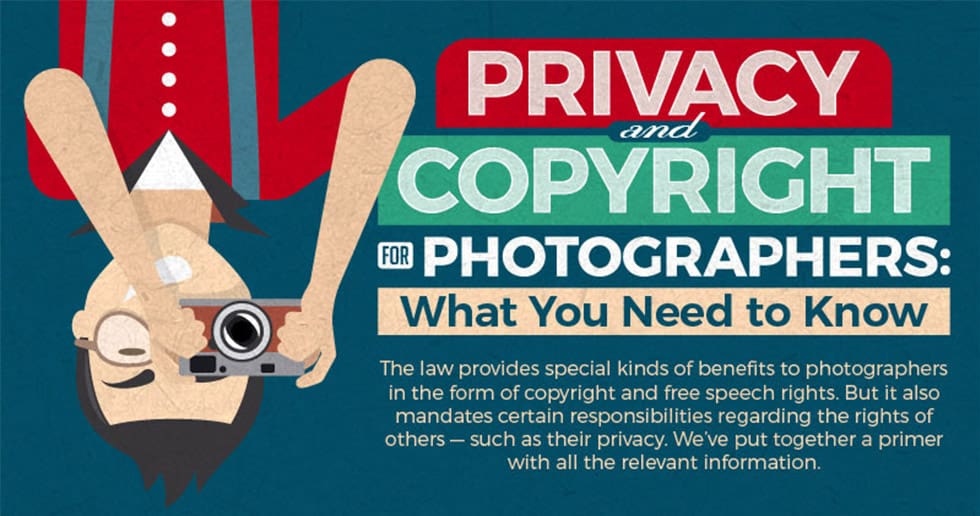Last Updated on 09/27/2019 by Mark Beckenbach
Today’s photography cheat sheet is all about the rights and responsibilities of photographers when it comes copyright and privacy.
Photographers are among the creatives whose works constantly faces copyright infringement issues. Likewise, many photographers aren’t aware of the responsibilities that come with the job, especially when it comes to street photography. To address this, we’re sharing an infographic that will serve as a handy photography cheat sheet for knowing your rights and responsibilities as a photographer. The infographic below, put together by WhoisHostingThis, is a primer on what you need to know about privacy and copyright issues you may encounter as a photographer. Knowing about copyright law will allow you to protect your work, while familiarity with the privacy law will allow you to avoid legal liabilities. We highly suggest that you keep a copy of this photography cheat sheet for instances when you’re in doubt.
Copyright Matters
A lot of us are sharing our photos online, whether personal projects or commissioned work, as part of our photography portfolio. We also post them on social media to get the word out about what we do and catch the interest of potential clients. But that also exposes our work to copyright issues like theft and unauthorized commercial use. The infographic tells us that copyright laws vary in different countries, but most implement versions roughly the same as the US copyright law. Any photo that you take is automatically copyrighted to you, and that copyright lasts as long as you’re alive. This means you have exclusive rights to copy and use your photographs and manage how they are used by others. Registering your photos with the Copyright Office is only required if you’re pursuing legal action for copyright infringement and you’re looking into getting greater penalties available.
While there’s no surefire way to protect your work, there are ways to deter downloads and unauthorized use. Among the suggestions in the infographic are watermarking, adding metadata, uploading low-resolution images, and placing a transparent image over your photos using CSS (so only the transparent image will be captured through the Copy + Paste function). JavaScripts and software can also disable copying, downloading, and printing the photos posted on your website.
You can also use the free copyright license offered by Creative Commons to choose the conditions through which the public can access and share your photos. If you use Behance for your professional portfolio, you might already be familiar with it. Keep in mind that Creative Commons does not replace the actual copyright terms, but works alongside it.
If you find that the copyright of one or some of your photos was infringed, the infographic has also outlined what you can do. It provides suggestions for documenting the infringement, contacting the infringer, and pursuing legal action.
There are also copyright issues that can arise on the part of the photographer. Keep in mind that objects you photograph like paintings, sculpture, and exhibited photos can be copyrighted.
Privacy Matters
Privacy laws, meanwhile, fall under the responsibilities that photographers need to keep in mind to avoid costly legal liabilities. Privacy concerns from the subjects you photograph — something that street photographers are typically familiar with. Generally, people’s recognizable bodies are protected from being photographed for commercial purposes without their permission. It also applies in locations that are private, such as their homes and public restrooms. You can also photograph public officials on duty as well as buildings and other property if you’re in a public space. Before you go out prowling the streets, make sure to brush up on the privacy laws of the city, state, or country you’re in for any specifics.
To protect yourself from lawsuit liabilities for defamation of character and invasion of privacy, make sure you prepare a model release between yourself and your models. You can download some samples online and tailor it to include details about your shoot and how the photos may be used. A release is also necessary if you’re shooting for commercial uses such as advertising, catalogs, promotions, and websites. The same goes for subjects who are recognizable through their faces, tattoos, or involvement in specific activities.
This cheat sheet is only meant to be a rough guide, so we highly suggest doing some additional research. When in doubt about any privacy or copyright issue, consulting a lawyer is your best course of action.
Looking for more useful photography tips and tricks? Make sure to check out all our photography cheat sheets so far!



